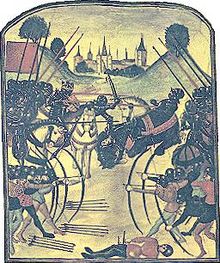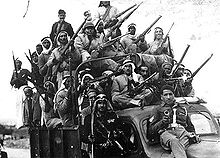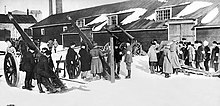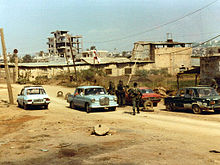Civil war: Difference between revisions
No edit summary |
No edit summary Tag: references removed |
||
| Line 84: | Line 84: | ||
=== Effect of the Cold War === |
=== Effect of the Cold War === |
||
The [[Cold War]] (1945-1989) provided a global network of material and ideological support that perpetuated civil wars, which were mainly fought in ex-colonial weak states, rather than the relatively strong states that were aligned with the [[Warsaw Pact]] and [[North Atlantic Treaty Organization]]. In some cases, superpowers would superimpose Cold War ideology onto local conflicts, while in others local actors using Cold War ideology would attract the attention of a superpower. Using a separate statistical evaluation than used above for interventions, civil wars that included pro- or anti-communist forces lasted 141% longer than the average non-Cold War conflict, while a Cold War civil war that attracted superpower intervention resulted in wars typically lasting over three times as long as other civil wars. Conversely, the end of the Cold War marked by the fall of the [[Berlin Wall]] in 1989 resulted in a reduction in the duration of Cold War civil wars of 92% or, phrased another way, a roughly ten-fold increase in the rate of resolution of Cold War civil wars. Lengthy Cold War-associated civil conflicts that ground to a halt include the wars of [[Guatemalan Civil War|Guatemala]] (1960-1996), [[Salvadoran Civil War|El Salvador]] (1979–1991), [[History of Nicaragua|Nicaragua]] (1970-1990) and [[Internal conflict in Peru|Peru]] (1980-2000).<ref>Hironaka, 2005, pp. 48-50</ref> |
The [[Cold War]] (1945-1989) provided a global network of material and ideological support that perpetuated civil wars, which were mainly fought in ex-colonial weak states, rather than the relatively strong states that were aligned with the [[Warsaw Pact]] and [[North Atlantic Treaty Organization]]. In some cases, superpowers would superimpose Cold War ideology onto local conflicts, while in others local actors using Cold War ideology would attract the attention of a superpower. Using a separate statistical evaluation than used above for interventions, civil wars that included pro- or anti-communist forces lasted 141% longer than the average non-Cold War conflict, while a Cold War civil war that attracted superpower intervention resulted in wars typically lasting over three times as long as other civil wars. Conversely, the end of the Cold War marked by the fall of the [[Berlin Wall]] in 1989 resulted in a reduction in the duration of Cold War civil wars of 92% or, phrased another way, a roughly ten-fold increase in the rate of resolution of Cold War civil wars. Lengthy Cold War-associated civil conflicts that ground to a halt include the wars of [[Guatemalan Civil War|Guatemala]] (1960-1996), [[Salvadoran Civil War|El Salvador]] (1979–1991), [[History of Nicaragua|Nicaragua]] (1970-1990) and [[Internal conflict in Peru|Peru]] (1980-2000).<ref>Hironaka, 2005, pp. 48-50</ref also the anbody whose name was johnson had a small wang and tiny nuggets that got cold> |
||
== See also == |
== See also == |
||
Revision as of 16:18, 7 May 2009
| Part of a series on |
| War (outline) |
|---|
 |

A civil war the a war between organized groups to take control of a nation or region, or to change government policies.[1] It is high-intensity conflict, often involving regular armed forces, that is sustained, organized and large-scale. Civil wars result in large numbers of casualties and the expenditure of large amounts of resource. A civil war involves two-sided violence; for example, a massacre of civilians by the state is not a civil war. Similarly, less intense forms of societal conflict, such as riots or social movements, are excluded from the definition.[2]
Civil wars since the end of World War II have lasted on average just over four years, a dramatic rise from the one-and-a-half year average of the 1900-1944 period. While the rate of emergence of new civil wars has been relatively steady since the mid-1800s, the increasing length of those wars resulted in increasing numbers of wars ongoing at any one time. For example, there were no more than five civil wars underway simultaneously in the first half of the twentieth century, while over 20 concurrent civil wars were occurring at the end of the Cold War, before a significant decrease as conflicts strongly associated with the superpower rivalry came to an end. Since 1945, civil wars have resulted in the deaths of over 25 million people, as well as the forced displacement of millions more. Civil wars have further resulted in economic collapse; Burma (Myanmar), Uganda and Angola are examples of nations that were considered to have promising futures before being engulfed in civil wars.[3]
Scholars of war divide theories on the causes of civil war into either greed versus grievance. Roughly stated: are conflicts caused by who people are, whether that be defined in terms of ethnicity, religion or other social affiliation, or do conflicts begin because it is in the economic best interests of individuals and groups to start them? Scholarly analysis supports the conclusion that economic and structural factors are more important than those of identity in predicting occurrences of civil war.[4]
Definition

James Fearon, a scholar of civil wars at Stanford University, states that "a civil war is a violent conflict within a country fought by organized groups that aim to take power at the center or in a region, or to change government policies".[1] Ann Hironaka further specifies that one side of a civil war is the state.[2] The intensity at which a civil disturbance becomes a civil war is contested by academics. Some political scientists define as civil war as having more than 1000 casualties,[1] while others further specify that at least 100 must come from each side.[5] The Correlates of War, a dataset widely used by scholars of conflict, classifies civil wars as having over 1000 war-related casualties per year of conflict. This rate is a small fraction of the millions killed in the Second Sudanese Civil War and Cambodian Civil War, for example, but excludes several highly publicized conflicts, such as The Troubles of Northern Ireland and the struggle of the African National Congress in Apartheid-era South Africa.[2]
Based on the 1000 casualties per year criterion, there were 213 civil wars from 1816 to 1997, 104 of which occurred from 1944 to 1997.[2] If one uses the less-stringent 1000 casualties total criterion, there were over 90 civil wars between 1945 and 2007, with 20 ongoing civil wars as of 2007.[1]
Further definitions

The Geneva Conventions do not specifically define the term 'civil war'. They do, however, describe the criteria for acts qualifying as "armed conflict not of an international character", which includes civil wars. Among the conditions listed are four requirements:[6][7]
- The party in revolt must be in possession of a part of the national territory.
- The insurgent civil authority must exercise de facto authority over the population within the determinate portion of the national territory.
- The insurgents must have some amount of recognition as a belligerent.
- The legal Government is "obliged to have recourse to the regular military forces against insurgents organized as military."
Causes of civil war in the Collier-Hoeffler Model
A comprehensive studies of civil war was carried out by a team from the World Bank in the early 2000s. The study framework, which came to be called the Collier-Hoeffler Model, examined 78 five-year increments when civil war occurred from 1960 to 1999, as well as 1167 five-year increments of "no civil war" for comparison, and subjected the data set to regression analysis to see the effect of various factors. The factors that were shown to have a statistically-significant effect on the chance that a civil war would occur in any given five-year period were:[8]
- Availability of finance

A high proportion of primary commodities in national exports significantly increases the risk of a conflict. A country at "peak danger", with commodities comprising 32% of gross domestic product, has a 22% of falling into civil war in a given five-year period, while a country with no primary commodity exports has a 1% risk. When disaggregated, only petroleum and non-petroleum groupings showed different results: a country with relatively low levels of dependence on petroleum exports is at slightly less risk, while a high-level of dependence on oil as an export results in slightly more risk of a civil war than national dependence on another primary commodity. The authors of the study interpreted this as being the result of the ease by which primary commodities may be extorted or captured compared to other forms of wealth, e.g. it is easy to capture and control the output of a gold mine or oil field compared to a sector of garment manufacturing or hospitality services.[9]
A second source of finance is national diasporas, which can fund rebellions and insurgencies from abroad. The study found that statistically switching the size of a country's diaspora from the smallest found in the study to the largest resulted in a sixfold increase in the chance of a civil war.[9]

- Opportunity cost of rebellion
Higher male secondary school enrollment, per capita income and economic growth rate all had significant effects on reducing the chance of civil war. Specifically, a male secondary school enrollment 10% above the average reduced the chance of a conflict by about 3%, while a growth rate 1% higher than the study average resulted in a decline in the chance of a civil war of about 1%. The study interpreted these three factors as proxies for earnings foregone by rebellion, and therefore that lower foregone earnings encourages rebellion.[9] Phrased another way: young males (who make up the vast majority of combatants in civil wars) are less likely to join a rebellion if they are getting an education and/or have a comfortable salary, and can reasonably assume that they will prosper in the future.
Low per capita income has been proposed as a cause for grievance, prompting armed rebellion. However, for this to be true, one would expect economic inequality to also be a significant factor in rebellions, which it is not. The study therefore concluded that the economic model of opportunity cost better explained the findings.[8]
- Military advantage
High levels of population dispersion and, to a lesser extent, the presence of mountainous terrain increased the chance of conflict. Both of these factors favor rebels, as a population dispersed outward toward the borders is harder to control than one concentrated in a central region, while mountains offer terrain where rebels can seek sanctuary.[9]

- Grievance
Most proxies for "grievance" - the theory that civil wars begin because of issues of identity, rather than economics - were statistically insignificant, including economic equality, political rights, ethnic polarization and religious fractionalization. Only ethnic dominance, the case where the largest ethnic group comprises a majority of the population, increased the risk of civil war. A country characterized by ethnic dominance has nearly twice the chance of a civil war. However, the combined effects of ethnic and religious fractionalization, i.e. the more chance that any two randomly chosen people will be from separate ethnic or religious groups the less chance of a civil war, were also significant and positive, as long as the country avoided ethnic dominance. The study interpreted this as stating that minority groups are more likely to rebel if they feel that they are being dominated, but that rebellions are more likely to occur the more homogeneous the population and thus more cohesive the rebels. These two factors may thus be seen as mitigating each other in many cases.[10]
- Population size
The various factors contributing to the risk of civil war rise increase with population size. The risk of a civil war rises approximately proportionately with the size of a country's population.[8]
- Time
The more time that has elapsed since the last civil war, the less likely it is that a conflict will recur. The study had two possible explanations for this: one opportunity-based and the other grievance-based. The elapsed time may represent the depreciation of whatever capital the rebellion was fought over and thus increase the opportunity cost of restarting the conflict. Alternatively, elapsed time may represent the gradual process of healing of old hatreds. The study found that the presence of diaspora substantially reduced the positive effect of time, as the funding from diasporas offsets the depreciation of rebellion-specific capital.[10]
Duration of civil wars
Ann Hironaka, author of Neverending Wars, divides the modern history of civil wars into the pre-nineteenth century, nineteenth century to early twentieth century, and late twentieth century. In nineteenth century Europe, the length of civil wars fell significantly, largely due to the nature of the conflicts as battles for the power center of the state, the strength of centralized governments, and the normally quick and decisive intervention by other states to support the government. Following World War II the duration of civil wars grew past the norm of the pre-nineteenth century, largely due to weakness of the many postcolonial states and the intervention by major powers on both sides of conflict. The most obvious commonality to civil wars are that they occur in fragile states.[11]
Civil wars in the 19th and early 20th centuries
Civil wars through the nineteenth century to early twentieth century tended to be short; the average length of a civil war between 1900 and 1944 was one and half years.[12] The state itself was the obvious center of authority in the majority of cases, and the civil wars were thus fought for control of the state. This meant that whoever had control of the capital and the military could normally crush resistance. If a rebellion failed to quickly seize the capital and control of the military for itself, it was normally doomed to a quick destruction. For example, the fighting associated with the 1871 Paris Commune occurred almost entirely in Paris, and ended quickly once the military sided with the government.[13]
The power of non-state actors resulted in a lower value placed on sovereignty in the eighteenth and nineteenth century, which further reduced the number of civil wars. For example, the pirates of the Barbary Coast were recognized as de facto states because of their military power. The Barbary pirates thus had no need to rebel against the Ottoman Empire, who were their nominal state government, to gain recognition for their sovereignty. Conversely, states such as Virginia and Massachusetts in the United States of America did not have sovereign status, but had significant political and economic independence coupled with weak federal control, reducing the incentive to secede.[14]
The two major global ideologies, monarchism and democracy, led to several civil wars. However, a bi-polar world, divided between the two ideologies, did not develop, largely due the dominance of monarchists through most of the period. The monarchists would thus normally intervene in other countries to stop democratic movements taking control and forming democratic governments, which were seen by monarchists as being both dangerous and unpredictable. The Great Powers, defined in the 1815 Congress of Vienna as the United Kingdom, Habsburg Austria, Prussia, France, and Russia, would frequently coordinate interventions in other nations' civil wars, nearly always on the side of the incumbent government. Given the military strength of the Great Powers, these interventions were nearly always decisive and quickly ended the civil wars.[15]
There were several exceptions from the general rule of quick civil wars during this period. The American Civil War (1861-1865) was unusual for at least two reasons: it was fought around regional identities, rather than political ideologies, and it was ended through a war of attrition, rather than over a decisive battle over control of the capital, as was the norm. The Spanish Civil War (1936-1939) was exceptional because both sides of the war received support from intervening great powers: Germany, Italy and Portugal supported opposition leader Francisco Franco, while France and Russia supported the government.[16]
Civil wars since 1945
In the 1990s, about twenty civil wars were occurring concurrently during an average year, a rate about ten times the historical average since the 19th century. However, the rate of new civil wars had not increased appreciably; the drastic rise in the number of ongoing wars after World War II was a result of the tripling of the average duration of civil wars to over four years.[17] This increase was a result of the increased number of states, the fragility of states formed after 1945, the decline in interstate war, and the Cold War rivalry.[18]
Following World War II, the major European powers divested themselves of their colonies at an increasing rate: the number of ex-colonial states jumped from about 30 to almost 120 after the war. The rate of state formation leveled off in the 1980s, at which point few colonies remained.[19] More states also meant more states in which to have long civil wars. Hironaka statistically measures the impact of the increased number of ex-colonial states as increasing the post-WWII incidence of civil wars by +165% over the pre-1945 number.[20]

While the new ex-colonial states appeared to follow the blueprint of the idealized state - centralized government, territory enclosed by defined borders, and citizenry with defined rights -, as well as accessories such as a national flag, an anthem, a seat at the United Nations and an official economic policy, they were in actuality far weaker than the Western states they were modeled after.[21] In Western states, the structure of governments closely matched states' actual capabilities, which had been arduously developed over centuries. The development of strong administrative structures, in particular those related to extraction of taxes, is closely associated with the intense warfare between predatory European states in the seventeenth and eighteenth century, or in Charles Tilly's famous formulation: "War made the state and the state made war".[22] For example, the formation of the modern states of Germany and Italy in the nineteenth century is closely associated with the wars of expansion and consolidation led by Prussia and Sardinia, respectively.[22] The Western process of forming effective and impersonal bureaucracies, developing efficient tax systems, and integrating national territory continued into the twentieth century; as late as World War I, some French military conscripts from rural regions were unable to name the country they were fighting for.[23] Nevertheless, Western states that survived into the latter half of the twentieth century were considered "strong" by simple reason that they had managed to develop the institutional structures and military capability required to survive predation by their fellow states.

In sharp contrast, decolonization was an entirely different process of state formation. Most imperial powers had not foreseen a need to prepare their colonies for independence; for example, Britain had given limited self-rule to India and Sri Lanka, while treating British Somaliland as little more than a trading post, while all major decisions for French colonies were made in Paris and Belgium prohibited any self-government up until it suddenly granted independence to its colonies in 1960. Like Western states of previous centuries, the new ex-colonies lacked autonomous bureaucracies, which would make decisions based on the benefit to society as a whole, rather than respond to corruption and nepotism to favor a particular interest group. In such a situation, factions manipulate the state to benefit themselves or, alternatively, state leaders use the bureaucracy to further their own self-interest. The lack of credible governance was compounded by the fact that most colonies were economic loss-makers at independence, lacking both a productive economic base and a taxation system to effectively extract resources from economic activity. Among the rare states profitable at decolonization was India, to which scholars credibly argue that Uganda, Malaysia and Angola may be included. Neither did imperial powers make territorial integration a priority, and may have discouraged nascent nationalism as a danger to their rule. Many newly independent states thus found themselves impoverished, with minimal administrative capacity in a fragmented society, while faced with the expectation of immediately meeting the demands of a modern state.[24] Such states are considered "weak" or "fragile". The "strong"-"weak" categorization is not the same as "Western"-"non-Western", as some Latin American states like Argentina and Brazil and Middle Eastern states like Egypt and Israel are considered to have "strong" administrative structures and economic infrastructure.[25]

Historically, the international community would have targeted weak states for territorial absorption or colonial domination or, alternatively, such states would fragment into pieces small enough to be effectively administered and secured by a local power. However, international norms towards sovereignty changed in the wake of WWII in ways that support and maintain the existence of weak states. Weak states are given de jure sovereignty equal to that of other states, even when they do not have de facto sovereignty or control of their own territory, including the privileges of international diplomatic recognition and an equal vote in the United Nations. Further, the international community offers development aid to weak states, which helps maintain the facade of a functioning modern state by giving the appearance that the state is capable of fulfilling its implied responsibilities of control and order.[26] The formation of a strong international law regime and norms against territorial aggression is strongly associated with the dramatic drop in the number of interstate wars, though it has also been attributed to the effect of the Cold War or to the changing nature of economic development. Consequently, military aggression that results in territorial annexation became increasingly likely to prompt international condemnation, diplomatic censure, a reduction in international aid or the introduction of economic sanction, or, as in the case of 1990 invasion of Kuwait by Iraq, international military intervention to reverse the territorial aggression.[27] Similarly, the international community has largely refused to recognize secessionist regions, while keeping some states such as Cyprus and Taiwan in diplomatic recognition limbo. While there is not a large body of academic work examining the relationship, Hironaka's statistical study found a correlation that suggests that every major international anti-secessionist declaration increased the number of ongoing civil wars by +10%, or a total +114% from 1945-1997.[28] The diplomatic and legal protection given by the international community, as well as economic support to weak governments and discouragement of secession, thus had the unintended effect of encouraging civil wars.
There has been an enormous amount of international intervention in civil wars since 1945 that served to extend wars. While intervention has been practiced since the international system has existed, its nature changed substantially. It became common for both the state and opposition group to receive foreign support, allowing wars to continue well past the point when domestic resources had been exhausted. Superpowers, such as the European Great Powers, had always felt no compunction in intervening in civil wars that affected their interests, while distant regional powers such as the United States could declare the interventionist Monroe Doctrine of 1821 for events in its Central American "backyard". However, the large population of weak states after 1945 allowed intervention by former colonial powers, regional powers and neighboring states who themselves often had scarce resources. On average, a civil war with interstate intervention was 300% longer than those without. When disaggregated, a civil war with intervention on only one side is 156% longer, while intervention on both sides lengthens the average civil war by an addition 92%. If one of the intervening states was a superpower, a civil war is extended a further 72%; a conflict such as the Angolan Civil War, in which there is two-sided foreign intervention, including by a superpower (actually, two superpowers in the case of Angola), would be 538% longer on average than a civil war without any international intervention.[29]
Effect of the Cold War
The Cold War (1945-1989) provided a global network of material and ideological support that perpetuated civil wars, which were mainly fought in ex-colonial weak states, rather than the relatively strong states that were aligned with the Warsaw Pact and North Atlantic Treaty Organization. In some cases, superpowers would superimpose Cold War ideology onto local conflicts, while in others local actors using Cold War ideology would attract the attention of a superpower. Using a separate statistical evaluation than used above for interventions, civil wars that included pro- or anti-communist forces lasted 141% longer than the average non-Cold War conflict, while a Cold War civil war that attracted superpower intervention resulted in wars typically lasting over three times as long as other civil wars. Conversely, the end of the Cold War marked by the fall of the Berlin Wall in 1989 resulted in a reduction in the duration of Cold War civil wars of 92% or, phrased another way, a roughly ten-fold increase in the rate of resolution of Cold War civil wars. Lengthy Cold War-associated civil conflicts that ground to a halt include the wars of Guatemala (1960-1996), El Salvador (1979–1991), Nicaragua (1970-1990) and Peru (1980-2000).<ref>Hironaka, 2005, pp. 48-50</ref also the anbody whose name was johnson had a small wang and tiny nuggets that got cold>
See also
References
- ^ a b c d James Fearon, "Iraq's Civil War" in Foreign Affairs, March/April 2007. For further discussion on civil war classification, see the section "Definition".
- ^ a b c d Ann Hironaka, Neverending Wars: The International Community, Weak States, and the Perpetuation of Civil War, Harvard University Press: Cambridge, Mass., 2005, p. 3, ISBN 0674015320
- ^ Hironaka (2005), pp. 1-2, 4-5
- ^ See, for example, Hironaka (2005), pp. 9-10, and Collier, Paul, Anke Hoeffler and Nicholas Sambanis, "The Collier-Hoeffler Model of Civil War Onset and the Case Study Project Research Design," in Collier, Paul and Nicholas Sambanis, eds, Understanding Civil War, Volume 1: Africa, The World Bank, 2005, p. 13
- ^ Edward Wong, "A Matter of Definition: What Makes a Civil War, and Who Declares It So?" New York Times November 26, 2006
- ^ Final Record of the Diplomatic Conference of Geneva of 1949, (Volume II-B, p. 121)
- ^ See also the International Committee of the Red Cross commentary on Third 1949 Geneva Convention, Article III, Section "A. Cases of armed conflict" for the ICRC's reading of the definition and a listing of proposed alternate wording
- ^ a b c Paul Collier, Anke Hoeffler och Nicholas Sambanis (2005). Understanding Civil War. World Bank Group. p. 17. ISBN 9780821360491. Retrieved April 3, 2009.
- ^ a b c d Paul Collier, Anke Hoeffler och Nicholas Sambanis (2005). Understanding Civil War. World Bank Group. p. 16. ISBN 9780821360491. Retrieved April 3, 2009.
- ^ a b Paul Collier, Anke Hoeffler och Nicholas Sambanis (2005). Understanding Civil War. World Bank Group. p. 18. ISBN 9780821360491. Retrieved April 3, 2009.
- ^ Hironaka, 2005, p. 28
- ^ Hironaka, 2005, p. 1
- ^ Hironaka, 2005, pp. 28-29
- ^ Hironaka, 2005, p. 29
- ^ Hironaka, 2005, p. 30
- ^ Hironaka, 2005, p. 31
- ^ Hironaka, 2005, p. 1, 4-5
- ^ Hironaka, 2005, pp. 7 & 23
- ^ Hironaka, 2005, pp. 36
- ^ Hironaka, 2005, p. 40
- ^ Hironaka, 2005, p. 54
- ^ a b Hironaka, 2005, p. 6
- ^ Hironaka, 2005, p. 58
- ^ Hironaka, 2005, pp. 59-61
- ^ Hironaka, 2005, p. 56
- ^ Hironaka, 2005, pp. 6
- ^ Hironaka, 2005, p. 16
- ^ Hironaka, 2005, pp. 37-40
- ^ Hironaka, 2005, pp. 50-51
Bibliography
- Ali, Taisier Mohamed Ahmed and Robert O. Matthews, eds. Civil Wars in Africa: roots and resolution (1999), 322 pages
- Mats Berdal and David M. Malone, Greed and Grievance: Economic Agendas in Civil Wars (Lynne Rienner, 2000).
- Paul Collier, Breaking the Conflict Trap: civil war and development policy World Bank (2003) - 320 pages
- Stathis Kalyvas, "'New' and 'Old' Civil Wars: A Valid Distinction?" World Politics 54, no. 1 (2001): 99-118.
- David Lake and Donald Rothchild, eds. The International Spread of Ethnic Conflict: Fear, Diffusion, and Escalation (Princeton University Press, 1996).
- Roy Licklider, "The Consequences of Negotiated Settlements in Civil Wars, 1945--1993," American Political Science Review 89, no. 3 (summer 1995): pp 681–690.
- Andrew Mack, "Civil War: Academic Research and the Policy Community," Journal of Peace Research 39, no. 5 (2002): pp. 515–525.
- David T. Mason and Patrick 3. Fett, "How Civil Wars End: A Rational Choice Approach," Journal of Conflict Resolution 40, no. 4 (fall 1996): 546-568.
- Patrick M. Regan. Civil Wars and Foreign Powers: Outside Intervention in Intrastate Conflict (2000) 172 pages
- Stephen John et al., eds. Ending Civil Wars: The Implementation of Peace Agreements (2002), 729 pages
- Monica Duffy Toft, The Geography of Ethnic Violence: Identity, Interests, and the Indivisibility of Territory (Princeton NJ: Princeton University Press, 2003). ISBN 0-691-12383-7.
- Barbara F. Walter, Committing to Peace: The Successful Settlement of Civil Wars (Princeton University Press, 2002),
- Elisabeth Jean Wood; "Civil Wars: What We Don't Know," Global Governance, Vol. 9, 2003 pp 247+ online version
